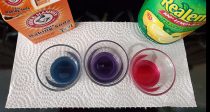Parental supervision is highly recommended for this activity.
This activity was created exclusively for STEAMfest by Shannon Blakely a Woodlawn parent.
pH indicators measure the amount of hydrogen ions present. The more hydrogen ions present, the more acidic, and the lower the pH. The less hydrogen ions present, the more basic, and the higher the pH. When used to test foods and other substances, pH test strips vary in color based on that presence or absence of hydrogen.
Additional items that could be used for testing (the Internet is a useful tool for suggestions as well):
- Apple
- Orange
- Tomato
- Potato
- Garlic
- Soybeans
- Other fruits or vegetables
- Egg white
- Egg yolk (yes, they have different pH’s)
- Nut/Seed butters
- Soda
- Bicarbonate
- Salt
- Sugar
- Dish soap
- Toothpaste
- Alka Seltzer
Handy items useful for prepping foods:
- Garlic press for pressing out juices
- Potato peeler
- Water for dissolving items
- How many items did you test with your pH indicator test strips? If you have a picture from your own experiments with your homemade pH test strips or a picture of your completed downloadable worksheet, please share. We’d love to see your results!
- Hopefully, your pH test strips varied in color depending on the item tested. What color was your favorite test strip and what was the food that produced that color?
- Did you test any items not listed in this activity? If so, what else did you test and what did you find? If you didn’t test anything new, did you find a pH change that surprised you? If so, tell us what the item was and what surprised you?
Earn badges and qualify for prize drawing by registering and answering journal questions. It's fun and easy!


